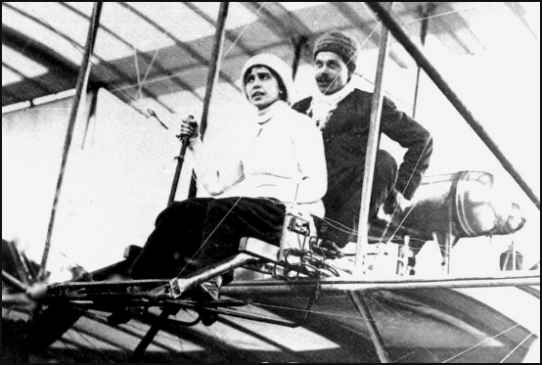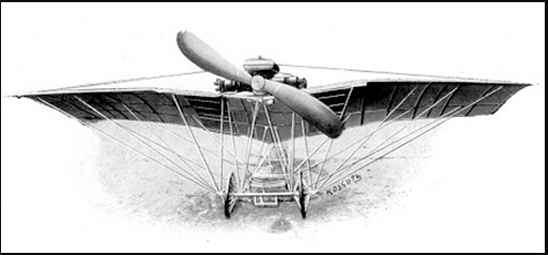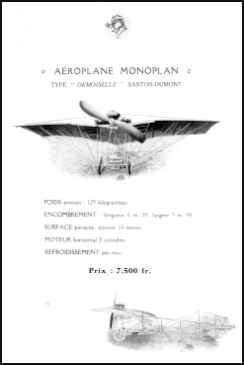
 |
|
Collection of Jean-Pierre Lauwers |
|
from Jean-Pierre Lauwers Herewith translated from the French a brief text on Hélène Dutrieux. Belgian first licensed female pilot! In Belgium, her Aé.C.B. License was number 27. |
 |
|
Collection of Jean-Pierre Lauwers |
|
She learned flying in a Demoiselle plane, as she was under contract to the French Clément-Bayard
factories. They built the "Demoiselle 20 and 21" types under license! The original Santos-Dumont "Demoiselle" was the number 19!
It is widely reported that she started flying the "Demoiselle" in December, 1908, without having taking any flight lessons or gaining any
experience! The result was that she crashed! Next she flew a "Sommer" plane, and crashed it as well in Russia. After some flight lessons in France, she made her solo flight on August 23, 1910 in a Farman III. For some reason, the examiners asked her to take the test over again! She refused saying that she had to be in Belgium for a Exhibition Flight. This was at Blankenberge on September 3, 1910. There she took her mechanic Béaud as a passenger and made a flight from Blankenberge to Bruges and return! My books says : She was the first Belgian female pilot. She was the first female pilot to realise a distance flight between two cities in Belgium. She was the first female pilot to do it with a passenger... She was the first female pilot of the world to have flown with a passenger... Although her records were not recognized by the FAI, in fact she broke three records by this flight with one passenger (as female pilot!): Distance: 45 km, altidude : 400 m, time 40 minutes. November 25, 1910, she got her license by the Aé.C.B. delivered n° 27. On December 5, 1910, she made a flight of 1h 11' ! She was the first female pilot to have flown more than one hour. In 1911, she participated in several air meets in Europe and the USA. She won the French Femina Cup for female aviators...and so on! |
 |
TYPE "DEMOISELLE" SANTOS-DUMONT  POIDS environ : 125 Kilogrammes. ENCOMBREMENT : longuer 6 m. 20, largeur 5 m. 50. SURFACE portante, environ 10 metres. MOTEUR horizontal 2 cylinders. REFROIDISSEMENT par eau. |
|
Collection of Jean-Pierre Lauwers |
|
by David Lam Like so many of the other early female aviators, she was a sportswoman who took up flying as a new sport. She lived in Paris, where she was a music-hall performer. Further, she was a champion on the bicycle, holding several speed records, including those of 1897-99. She also specialized in motorcycle riding, where she demonstrated the loop the loop at exhibitions. After an introduction to flying in a Santos-Dumont "Desmoiselle" at Issy-Les-Moiulilneaux in December 1908, she studied flying at the Farman School, and would have been the third woman in the world licensed, except that for administrative reasons her French license was not approved when the judges did not think her performance was adequate (she apparently tried to take it under Belgian rules, and the French would not agree that she had passed the requirements). She was reportedly the first female pilot to carry a passenger in flight (19 April 1910). Subsequently, she got her license in Belgium (#27 of 25 November 1910). She was the first holder of the Coupe Femina, which she won by setting women's duration and altitude records (beating Marie Marvingt, who was the first temporary leader in the contest). She flew for 1 hour 7 minutes (first woman to remain airborne more than one hour), and later (21 Dec 1910) extended this to 2 hours 35 minutes. She flew more than 167 kilometers. Subsequently, she participated in many exhibitions and meetings throughout Europe and North America. In 1911, she rewon the Femina Cup temporarily (it was finally won by Marie Marvingt) with a flight of 2 hours 58 minutes and covering 254 km. In 1913 she won the French Legion of Honneur, the first female pilot so decorated. In later years, she became the Vice-President of the womens section of the Aero-club of France, and started the Coupe Hélène-Dutrieu-Mortier, providing 200,000 Francs for the woman who could fly the greatest distance without landing. She died in Paris on 25 June 1961, aged 84. |
|
by email from David Lam, 2-15-04 She started in competitive cycling in 1895-- and pretty well stopped it by the end of 1898, when she took up auto racing. World Record for women-- distance traveled in one hour. 1895 Championship of the world for speed (women) at Ostende-- August 1897 and August 1898 Grand Prize of Europe August 1898 Took part in many exhibitions throughout Europe Won "Cours de 12 Jours" in London -- November 1898 Leopold II of Belgium gave her the Cross of St. Andre with diamonds in honor of her exploits-- 1898. She tried out her "looping the loop" at the Eldorado in Marseilles in 1903, then in September that year did the same at " l'Olympia". (I have no idea exactly what that means, or its location, though I suspect Paris-- it comes from an extract from an unidentifiable 1962 book I found in the air Museum files at Brussels.) This was done on an enclosed vertical circular track She then decided to delete the closed track, to do the loop in the open air, and to add a summersault to the trick. She got the vice president of the automobile club, M. Hospitalier, to work with her . She rented some land at Boulogne-sur-Seine, and had some plans drawn up by an architect, M. Frossard. Her new track was built by an engineer, M. Vert. , and the new trick was apparently a great success. She gave an interview once in which she noted that "when bicycles lost their attraction as a novelty, I started racing automobiles-- That was a sport!" She got into "looping cars", and was badly injured in an accident in Berlin, spending 6 months recuperating. I have no really detailed references for you, but you may find something in the following, which each contain a few anecdotes of her cycling days: Osta, "Une Compatriote", Air Revue, April 1956 pages 175-176 Severine, "l'Oiselle", L'Intransigeant, 1 January 1912 Lebow, "Before Amelia", Brassey's 2002 Beauregard, "Femmes de l'Air", France-Empire, 1993 Marck, "Les Aviatrices", L'Archipel, 1993 |
|
Tragedy Mars the Aviation Meet at Nassau, L. I. Five of the Most Prominent Aviators Entered for the Meet Withdraw from the Contest," Daily Journal and Tribune, Knoxville, Tennessee: September 26, 1911, Transcribed by Bob Davis - 11-25-03 "Dr. Clarke had not intended to fly today in his machine, which is numbered thirteen. This morning, however, after Ignatus Seminonk, the Russian aviator, had flown to Mineola and back, in Dr. Clarke's machine the wheels were smashed by the bad landing, and the doctor was so concerned over the accident that after repairs had been made he took the flyer up to test it. He had flown only 500 yards rising rapidly when he seemed to lose control and was dashed to the turf. As the aeroplane crashed on the ground it turned over, catching the amateur aviator under it and crushing him. Five of the most prominent aviators entered for the meet this afternoon withdrew from the contest. Eugene Ely, George W. Beatty, Harry Atwood, Bud Mars and J.A.D. McCurdy were those who decided to discontinue their flights. Ely and McCurdy expressed dissatisfaction with the rules while the three others stated that there was not enough money in the meet for them. Mlle. Héléne Dutrieu refused to fly today until she received more money. "In the speed contest for monoplanes today, Grahame-White won the prize of 600, flying ten miles at an average speed of sixty-one and one half miles an hour. Matilda Moisant went up 1,414 feet. In the bomb-dropping event, Beatty's passenger, Genevive O'Hagan, dropped the missle five feet and nine inches from the bull's eye, winning the event. "Tomorrow Postmaster-General Hitchcock is to fly with Grahame-White to Mineola, carrying several sacks of United states mail to personally test the possibility of aerial mail transportation." Bob Davis |


|